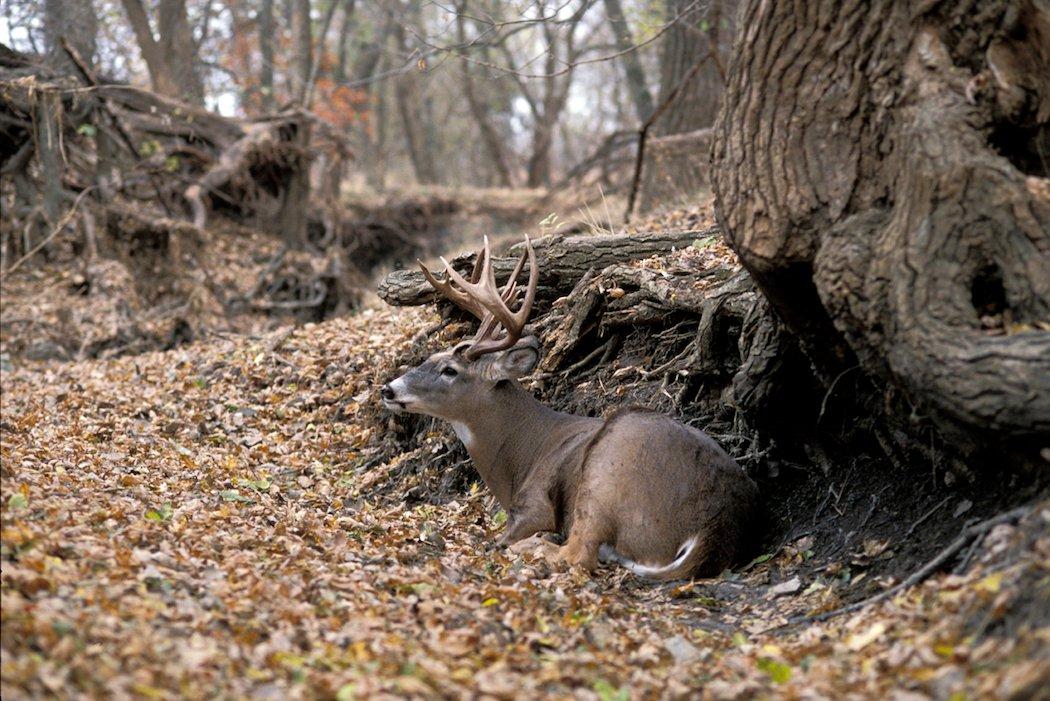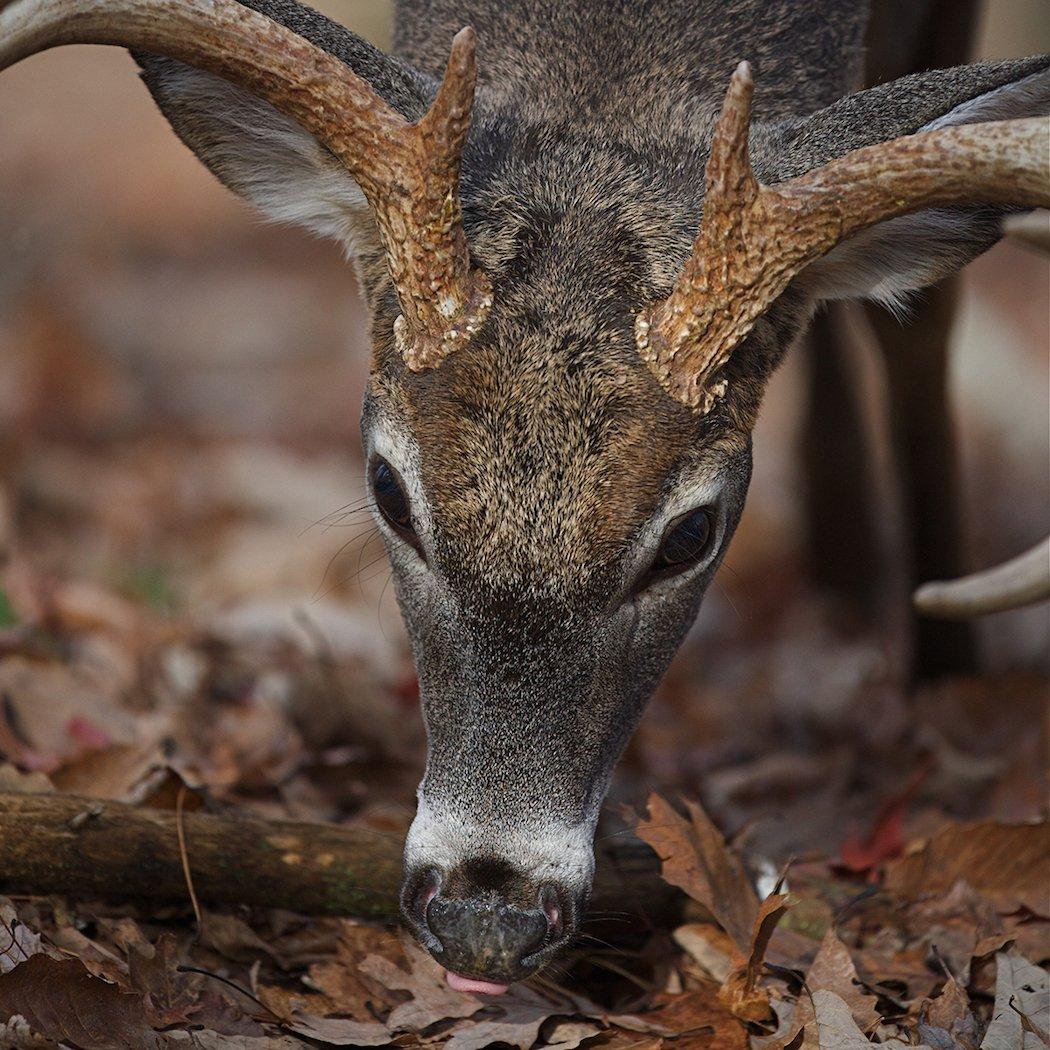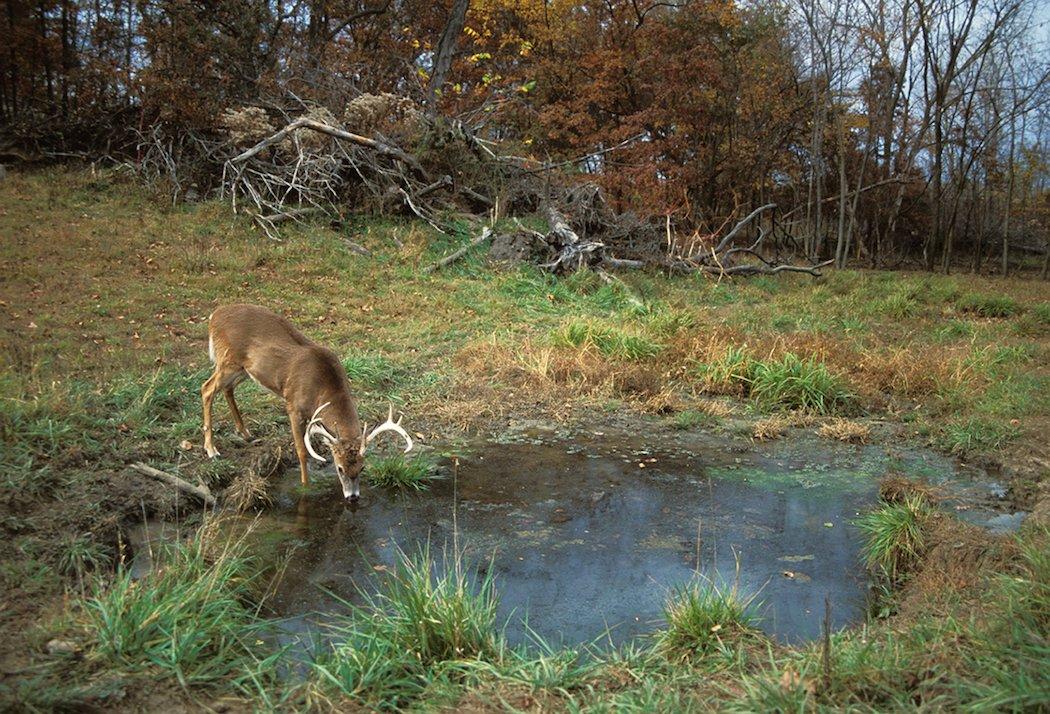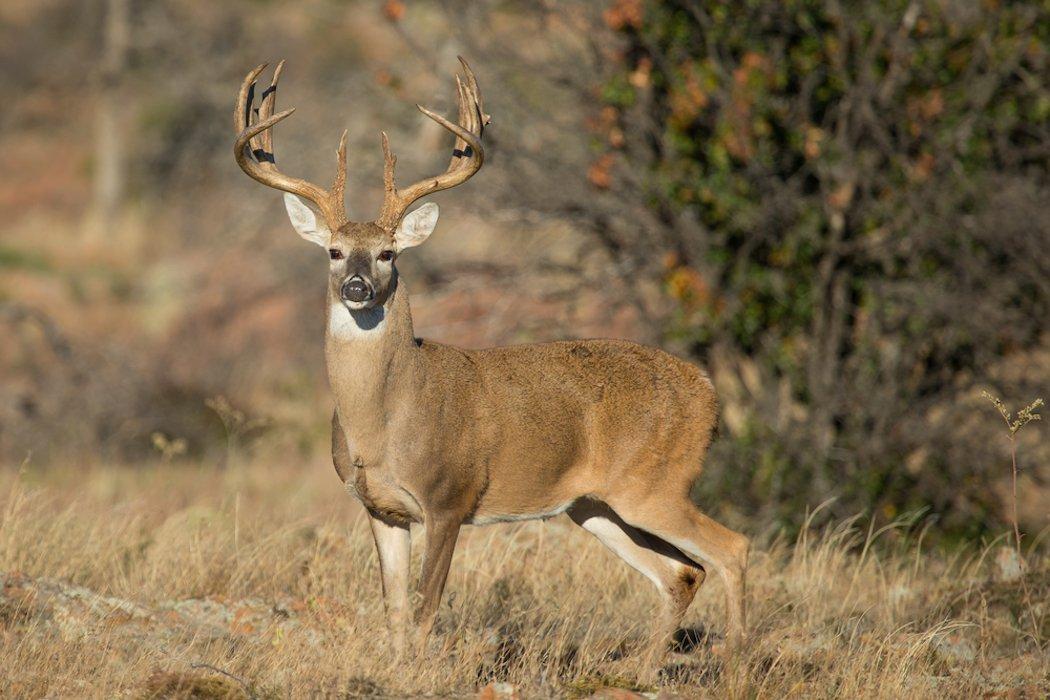Information to Know When Patterning Big Bucks
Habits are just that. They're things done repetitively in a manner that's predictable. And such are the things we look for in killable mature whitetails. Here are numerous habits to keep an eye out for when scouting and hunting.
Bedding Habits of Mature Deer
Getting close to mature bucks is a tough task. It's certainly an endeavor that isn't accomplished without sound judgment, attention to detail, habitat awareness, terrain-reading abilities, and skill. It's very difficult to do without an understanding of buck bedding behavior.
Here are eight common bedding habits that mature bucks live and die by. And in more cases than not, these things are what keep them alive.
1. Using Advantageous Terrain
There's a difference in hunting deer and hunting mature bucks. Deer — does and young bucks — will often bed much closer to food sources than mature bucks. In many cases, they bed in locations that provide much less security, too.
Mature bucks generally choose beds that provide some sort of advantage over predators. This is often directly related to the terrain type. For example, bucks frequently bed at the end of a ridge on a point. Bedding on these points usually allows them to see, smell and hear danger before it gets close enough to kill them. Look for areas that give deer the upper hand where you hunt, and that's generally where they'll be during daylight hours.
2. Hugging Tight to Food When Unpressured
Bucks that are pressured behave much differently than bucks that are unpressured. That's just the way it is. Outside of hunting season — mostly the spring and summer — virtually all mature bucks will bed close to food sources. They do so because of lack of fear. Hunters aren't chasing them at this time and their behavior reflects it. For those who hunt areas where the hunting pressure is relatively controlled, it's possible to hunt mature deer once the season begins that exhibit this same reckless behavior.
3. Bedding in Remote Locations When Pressured
The flip side of this is when hunters start hitting the woods. Everything changes once those mature deer catch wind (pun intended) of hunters. They relocate to bedding areas that provide better security and sanctuary. They move less during daylight. And the game gets that much harder.
4. Staying Close to Water
This is a very important variable that people often overlook. They get so wrapped up in food sources that water falls by the wayside. Studies show that deer often go to water before food when they get up in the evenings. Although not as important as cover and security, my experiences show this is an important factor when bucks choose bedding locations.
5. Their Backs to the Wall
Believe it or not, bucks often bed with their backs up against a log, rock or other object. This gives them additional cover and helps shield their presence from predators. It isn't as easy for hunters and predators to see deer when half their body is covered up.
6. Facing Downwind
Typically, bucks will bed against these solid objects (logs, rocks, etc.), watch downwind with their eyes, and cover their rear (upwind) with their nose. Of course, those ears are always on a swivel, too. This system allows deer to better protect themselves from danger.
7. Watching Their Back Trail
Just as it's ridiculous to think deer always walk into the wind, it's also ridiculous to say that deer ALWAYS do No. 5 and 6 above. That said, most of the time they do practice those two things. But even when they don't, bucks almost always seem to bed down and watch their back trail for predators.
8. Caution Varies
How cautious bucks are varies from buck to buck. Every whitetail has a different personality. Some bucks are warier than others. That's just the way it is. Beyond that, based on my experience, bedded bucks are warier of a morning than of an afternoon. Why? I'm not sure. Maybe bucks are restless and hungry by the afternoon and are more apt to throw caution to the wind. Maybe it's because they fear a predator might follow them back to bed of a morning and so they're more careful in their habits. Regardless, I feel bucks are more on edge when returning to their bedding areas than when they leave them.
Don't Miss: 5 Mature Buck Personalities We Hate
Feeding Habits of Mature Deer
Food is extremely important in deer hunting. Food is at the center of everything — even the rut. So when we're trying to stick a big deer, we have to take into account their feeding habits.
1. They Are Concentrate Selectors
This not only applies to big deer but all deer. What this means is deer consume the most nutrient-rich, highly palatable foods they can find. This often means they bite off the top of a plant, tip of a new shoot of grass, or bud on a tree or plant. They generally do not eat the entire plant, just the best part of it. Then, when they've bedded down, they'll regurgitate what they've eaten, chew their cud and digest it further before swallowing it again.
2. Food Drives Everything
Food is king. It's always king no matter the time of the season or year. Everything revolves around it — even bedding areas. Granted, mature deer choose bedding areas based on the security they provide. Bucks will travel great distances to reach a food source. But in areas where deer don't receive as much pressure — golden nuggets of land in the deer world — they give up some of that security to bed closer to food sources. In areas that are pressured, bucks will travel further and you won't ever see them on those major food sources. That means you have to hunt further away from food sources and closer to bedding areas.
3. They Feed in Staging Areas First
I generally don't hunt over major food sources when I'm trying to kill a mature deer that's on my radar. It is possible to catch a careless buck working a big field in daylight. But it's rare. However, it is much more common to see a big deer on its feet in daylight feeding in a staging area. These can be small food plots, pockets of dropped acorns, etc. Find these locations between bedding areas and major food sources. That's the best way to kill a mature buck while it's eating.
4. They Take Meandering Routes to the Dinner Table
Does and young bucks typically take a direct route to the food. They don't take as many precautions as mature bucks. The old ones, they take meandering routes to food sources. They play the wind. They play the thermals. They take travel routes that are strategic for them. In order to understand how this applies to where you hunt, you have to study that place and think like a wary deer.
5. Most Don't Make It to Major Food Sources Until After Dark
As previously mentioned, most mature bucks don't make it to major food sources until after the sun sets. It's a survival tactic. Move less in daylight and run into less hunters. How do we overcome that? Hunt further away from these food sources.
6. They Like Their Salad with Dressing
I've personally noticed that deer — and mature bucks — seem to move more right after a good rain. I don't have any data or science to support why that is. I just know they do. Who knows, maybe they like their salad with dressing.
7. Food Source Preferences Vary
Every buck has a different personality. Therefore, food source preferences will vary from buck to buck. Some bucks prefer beans to corn. Some prefer corn to beans. Some don't prefer either and stick to browse. Every deer is different. Determine what the individual deer you're after prefers by scouting.
8. Deer Take Cuisine Vacations
Recent studies have proven that deer go on excursions. They'll leave their home range and go elsewhere for a period of time. This can range from hours to days. But they take these vacations periodically. Now, I don't know what causes them to do this. No one does. And I'm not suggesting food is the reason. But one thing is for sure, they ain't eatin' at home when they do. They're using food sources they typically don't use. So if the deer you're hunting suddenly disappears, or if you see a new deer for a short period of time, this is likely what happened.
9. Feeding Habits Aren't Really Habits
Deer are very fickle creatures. And food sources are always changing. Because of that, their behavior, bedding areas, and travel routes are always changing, too. You have to stay ahead of them and know what food sources deer will be hitting before they hit them.
10. Deer Eat During the Day
Don't think deer don't move during the day. They do. And bucks don't lay down from dawn to dusk. They get up to feed. They get up to drink. They get up to relieve themselves. However, when mature deer do feed during the day, it's generally within 100 to 150 yards of their bedding area. So if you can find a good food source close to a thick bedding area, you'll be in the money for some action.
Don't Miss: What Deer Eat: A Seasonal Guide to Nutrition
Watering Habits of Mature Deer
Killing a mature buck isn't easy. It's actually pretty darn difficult. Because of that, I try to get inside the mind of a mature buck. That includes understanding bedding habits, feeding habits and watering habits. Those are a white-tailed buck's three basic needs.
1. They Will Drink Several Times Per Day
Deer are fairly large animals. A 200-pound buck will typically drink 3 to 5 quarts per day. This number fluctuates, but it does generally fall within that window.
2. Temperature Dictates Quantity
As mentioned, the amount of water that a deer will drink varies. The biggest factor in this fluctuation is temperature. The hotter it is the more water is needed to stay hydrated. Makes sense, right? This isn't something mature bucks are immune to. So especially on those hotter days, incorporate water into the hunt plan.
3. Buck Beds Will Be Relatively Close to a Water Source
Recent studies show that many deer — especially mature bucks — often bed close to water. Of the largest buck beds I've discovered in heavy cover, the vast majority of them have been located within 75 yards of a water source, even if it was a very small source.
4. Deer Often Go to Water Before Food of an Evening
Other studies show that mature deer — and deer in general — often go to water before food. You can take advantage of this by hunting near a water source located close to a bedding area.
5. They Don't Need Large Sources, A Puddle Will Do
Don't think deer require a nice, pretty pond or bubbling brook to drink out of. A rain puddle from the day before will suit them just fine. That's what makes it nearly impossible to use whitetails' need for water to kill them during times of rain. But you can also use this to your advantage when it's drier. Put in small water sources just outside of bedding areas, on travel routes, in staging areas, and within food plots for better success.
Don't Miss: How to Make 15-Dollar Watering Holes for Deer
Habits of Mature Rutting Bucks
Two words that you don't often hear in the same sentence are rut and habits. But one thing is for certain, bucks do certain things habitually during the rut each fall. You just have to know what to look for. And you have to know how it applies to your deer hunting. Here are seven of those things.
1. They Religiously Search for Does Within Their Home Range
Bucks are very devoted to finding does during the rut. That's what they do. And they cover their home range and then some in search of does each fall. However, every deer's personality is different and will travel more or less based upon their own inclinations.
2. They Feed Much Less During the Rut
Again, it depends on personality, but most bucks feed much less during the rut. Instead, they spend the majority of their time searching for does. They lose a lot of weight during this period and spend the summer and pre-rut building up fat stores to get them through the rut. In fact, bucks can lose as much as 20 to 30 percent of their body weight by rut's end.
3. They Move More During Midday Lunch Hours Than Other Times of the Year
Bucks are adaptive. They learn to move when people don't. Pressure affects them. That leads to quite a bit of midday movement during the rut.
4. They Cruise Certain Areas More Than Others
Mature bucks know where and how to find does during the rut. That's why you'll commonly find bucks cruising through doe bedding areas, leeward ridges, field edges, pinch-points, saddles, etc. Focus on traditional rut stand locations to target bucks during the rut.
5. They Spend Less Time Working Rubs and Scrapes Once Does Begin Entering Estrus
Once does start entering estrus, bucks spend less time laying down rut sign. Instead, they're more devoted to tending those does. Then, once the bulk of the breeding is over, they'll go back to tending scrapes more.
6. They Drive Estrus Does to the Thickest Cover
Mature bucks know that estrus does mean competition with other bucks. That's why, when they find an estrus doe, they'll push it into the nearest thick cover they can find. This helps them to defend the doe as other bucks try to move in.
7. They Spend 24 to 48 Hours with Estrus Does
Bucks will spend anywhere from 24 to 48 hours (sometimes even more) with a doe when it comes into estrus. This is referred to as the lock-down period. It's a very difficult time to hunt. You're either in the action or you're not. The best thing to do is hunt in or near thick cover when this phase begins.
Don't Miss: How to Hunt the Phases of the Rut
Are you a deer hunter wanting to learn how to accomplish your goals? Check out our stories, videos and hard-hitting how-to's on deer hunting.










